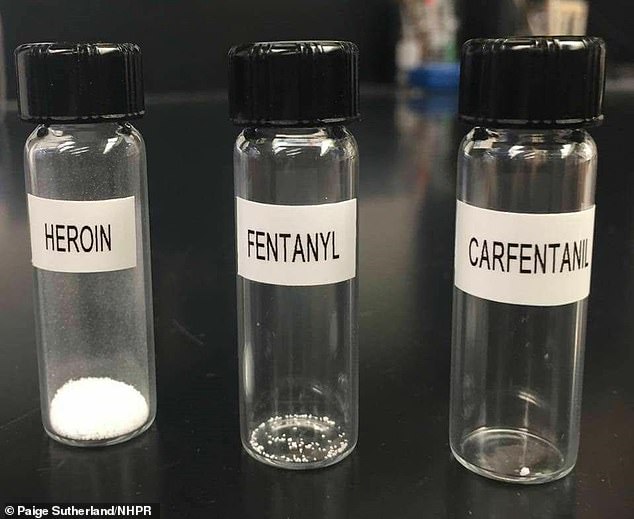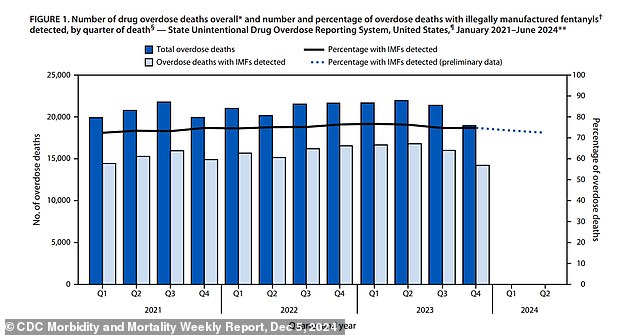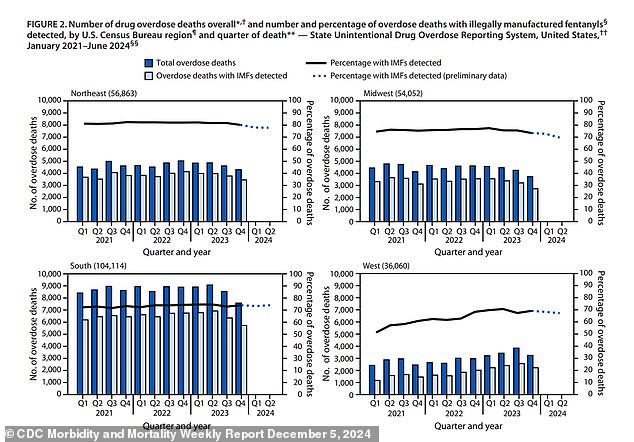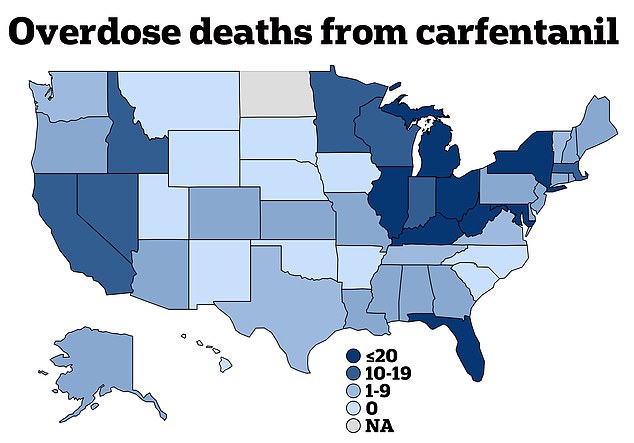Health officials warn of a drug 100 times more powerful than fentanyl that has caused deaths in 37 states in recent years.
The drug, called carfentanil, is a fentanyl derivative designed to tranquilize elephants and is the most potent commercial opioid on the market.
There were 513 carfentanil overdoses between January 2021 and June 2024, hitting states like Florida and West Virginia the hardest, according to a CDC report released today.
But while the overall numbers are low, officials are concerned because the total has increased sevenfold in the past year.
This could threaten to reverse a recent drop in drug overdoses seen in the country.
Carfentanil comes in powder, paper, tablets, patches, and spray forms, and can be inhaled, swallowed, or absorbed through the skin.
In its powder form, the drug mimics cocaine or heroin and is often mixed with other illegal drugs such as xylazine or counterfeit pills.
Just 2 milligrams, about one-fiftieth of a pinch of salt, of the drug can be lethal: slowing breathing to dangerous levels and causing brain damage or death.
The CDC report included data from January 2023 to June 2024, with the number of overdose deaths attributed specifically to carfentanil. Four states did not participate in the analysis

This image shows the lethal doses for an average adult of several opioids such as heroin, fentanyl, and carfentanil. Carfentanil is 100 times more potent than fentanyl and 10,000 times more potent than morphine.
CDC officials said: “Recent sharp increases in detected carfentanil overdose deaths, while rare, highlight the ever-changing illicit drug supply and threaten progress in reducing overdose deaths.”
According to the DEA, the drug is 10,000 times more potent than morphine and 100 times more potent than fentanyl.
It’s unclear where the drugs came from, but the report states they were likely manufactured illegally, not stolen from legal stash houses.
In a 2021 drug raid in Southern California, police found 21 kilos of drugs in the home of two American residents, Christine Ponce and Andrés Jesús Morales.
Before hitting the streets, carfentanil was originally designed in 1974 to treat large mammals such as elephants and bears.
It works on the same brain systems as codeine, heroin, and oxycodone and essentially stops or relieves pain. It is highly addictive.
Powdered fentanyls entered the United States later than other countries because they were difficult to mix with black tar heroin, which used to be more common, according to the CDC report.
But as prescription and counterfeit pills became more popular in recent decades, it became easier to introduce these super-potent opioids into the supply.

The CDC tracked the total number of overdose deaths each year and compared the number of those caused by illegally manufactured fentanyls (IMF), such as carfentanil. Although the total number of overdoses decreased, they said the number of carfentanil-specific overdoses was increasing.

In 2021, police seized 21 kilos of carfentanil at a couple’s home in Riverside County, California. It was the largest drug seizure in the area at that time.
In addition, distributors often mix products in their offering to make their products more powerful and cheaper, which makes users want more, according to the DEA.
The CDC report found that seven in 10 drug overdose deaths in the U.S. in 2023 involved fentanyl or one of its derivatives such as carfentanil.
The report used a national overdose reporting system, which compiles data from death certificates, coroner’s reports and toxicology reports to summarize drug overdose deaths. The new report included data from 2021 to 2023 for all overdoses, but tracked carfentanil specifically during the first half of 2024.
Of the 251,089 drug overdoses during the two-year period, 74 percent were related to fentanyl or a fentanyl-derived drug. In 2023, 63,734 Americans died from fentanyl or one of its derivatives.
The report found that the total number of overdose deaths has decreased quarter-over-quarter in 2023, as has the total number of illegal fentanyl-derived drugs on the streets.
However, at the same time, carfentanil overdoses have been on the rise.
Florida and West Virginia were the only two states with more than 20 drug-related deaths.
They were followed by Illinois, Indiana, Kentucky, Maryland, Michigan, New York and Ohio, which reported between 10 and 19 deaths from the drug over an 18-month period.

The CDC report also broke down overdoses by different geographic regions. Those from the IMF, the bars shaded in bright blue, refer to deaths related to fentanyl or its derivatives.

Alexandra Capelouto died after taking fentanyl two days before Christmas in 2019. Alexandra was 19 when she took what she thought was oxycodone to help her sleep.
Additionally, according to the CDC report, if carfentanil continues to spread: “overdose deaths could increase substantially.”
This is particularly concerning because this surge is substantially different from an outbreak that occurred in 2016, where it appeared to be contained to a few states.
The Drug Enforcement Administration (DEA) recommends that anyone who has been exposed to the drug seek immediate medical attention.
If someone is exposed to the drug, the DEA notes that early symptoms may include drowsiness, disorientation, pinpoint pupils, slow breathing, and clammy skin. At this point, they urge the person to call 911.
If left untreated, someone can stop breathing and lack of oxygen can lead to breathing problems or serious brain damage.
Professionals or bystanders can use naloxone, an FDA-approved medicinal inhaler, to reverse the overdose and prevent the worst outcomes, if they act quickly.
Chuck Rosenberg, who was the acting administrator of the DEA in 2016said about these drugs: ‘We see them on the streets, often disguised as heroin. It’s very dangerous.
Synthetics like fentanyl and carfentanil can kill you. “I hope our first responders, and the public, read and heed our health and safety warning.”

